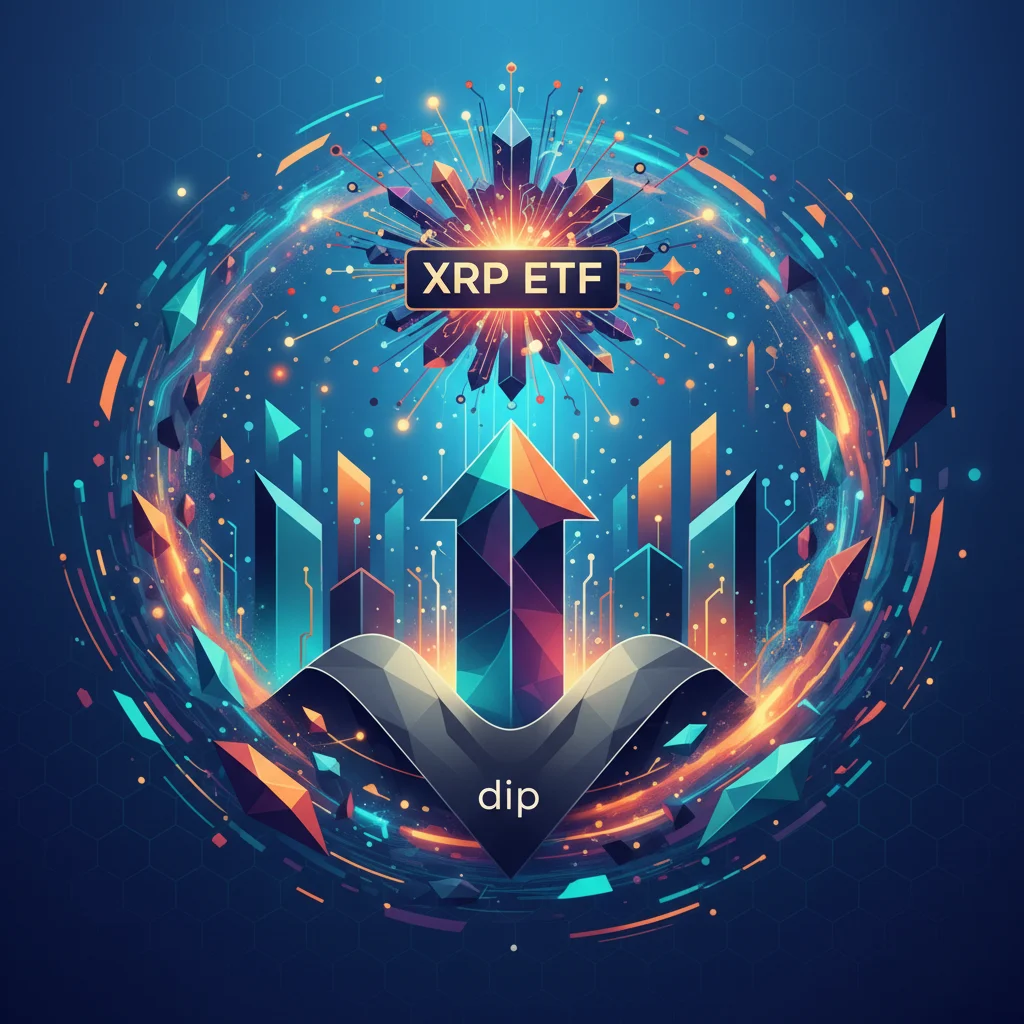
Beyond the Dip: Why an XRP ETF Could Be the Next Big Catalyst in Digital Finance
In the fast-paced world of digital assets, it’s easy to get caught up in the daily price charts. A recent 3% pullback in XRP’s value might cause a stir among short-term traders, but for those focused on the long-term evolution of finance, the real story is brewing behind the scenes. The whispers are growing louder: the potential for an XRP Exchange-Traded Fund (ETF) is no longer a distant dream but a tangible possibility that could fundamentally reshape institutional access to cryptocurrency.
While Bitcoin and Ethereum have rightfully captured headlines with their own ETF approvals, the conversation is now expanding. Key figures in both the crypto and traditional finance worlds are signaling that the door is open for other major digital assets. This isn’t just about another investment product; it’s about validating the underlying technology and integrating it into the global economic framework. This post will delve into why the prospect of an XRP ETF is such a monumental development, the significant regulatory hurdles that remain, and what it all means for the future of investing, fintech, and the broader stock market.
Understanding the Current Climate: Volatility vs. Vision
The cryptocurrency market is notoriously volatile. Short-term price fluctuations, like the recent dip in XRP, are often driven by a complex mix of macroeconomic factors, market sentiment, and speculative trading. However, seasoned investors and financial professionals know to look beyond this daily noise. The true value and long-term trajectory of an asset are dictated by more fundamental drivers: utility, adoption, and regulatory clarity.
In this context, the undercurrent of institutional interest is far more significant than a minor price correction. The successful launch of spot Bitcoin ETFs in early 2024 was a watershed moment. It demonstrated a massive, previously untapped demand from institutional players who were waiting for a regulated, familiar, and accessible vehicle to gain exposure to digital assets. This success has created a powerful precedent, and the market is now actively looking for “the next big thing.” Statements from influential leaders, including Ripple CEO Brad Garlinghouse and BlackRock CEO Larry Fink, have added significant fuel to the fire, suggesting that an XRP ETF is a matter of ‘when,’ not ‘if’ (source).
The ETF Effect: Unlocking Institutional Capital
So, why is an ETF considered the holy grail for a digital asset? The answer lies in its ability to bridge the gap between the complex world of blockchain and the established infrastructure of traditional finance.
An ETF is a type of investment fund that is traded on a stock exchange, just like a regular stock. For assets like XRP, this offers several transformative advantages:
- Accessibility: Instead of navigating crypto exchanges, private keys, and digital wallets, investors can buy an XRP ETF through their existing brokerage accounts (e.g., Fidelity, Charles Schwab). This drastically lowers the barrier to entry for both retail and institutional investors.
- Regulatory Wrapper: ETFs are highly regulated financial products. This provides a level of security, transparency, and investor protection that is often perceived as lacking in the direct crypto market, making conservative institutions like pension funds and endowments more comfortable with investing.
- Liquidity Injection: By opening the floodgates to vast pools of institutional capital, an ETF can dramatically increase an asset’s liquidity. This leads to more stable pricing, reduced volatility, and a deeper, more mature market. The Bitcoin ETFs, for example, attracted billions in net inflows within weeks of launching.
- Mainstream Validation: An ETF approval, particularly from the U.S. Securities and Exchange Commission (SEC), serves as a powerful stamp of legitimacy. It signals to the broader financial world that the asset is a recognized part of the investment landscape.
For XRP, an ETF would be particularly significant. It would not only boost its profile as an investment asset but also validate its core utility in the realm of financial technology—specifically, its role in facilitating fast and low-cost cross-border payments, a cornerstone of modern banking innovation. Strategic Deployment: What a National Guard Presence in Chicago Teaches Us About Financial Fortitude
The Elephant in the Room: The SEC and the Quest for Clarity
Despite the overwhelming potential, one colossal hurdle stands in the way of an XRP ETF: regulatory uncertainty. The long-running lawsuit between Ripple Labs and the SEC is the central drama that will determine XRP’s fate in the U.S. market.
The core of the dispute is whether XRP should be classified as a security. The SEC argues that it is, which would subject it to strict disclosure and registration requirements. Ripple contends that it is a digital commodity or a technology asset used to facilitate payments. While Ripple secured a partial victory in 2023 when a judge ruled that programmatic sales of XRP on exchanges did not constitute investment contracts, the legal battle is far from over (source). This lingering ambiguity is a non-starter for major asset managers considering an ETF.
Before any institution like BlackRock or Fidelity would risk filing for an XRP ETF, they need a clear, unambiguous statement from regulators that XRP is not a security. This clarity is the essential green light. To put this in perspective, here is a simplified comparison of the regulatory standing of the top digital assets in the U.S.:
| Asset | General Regulatory Classification (U.S.) | ETF Status (Spot) | Key Considerations |
|---|---|---|---|
| Bitcoin (BTC) | Widely considered a commodity by the CFTC and SEC. | Approved and trading since January 2024. | Clear regulatory status was the key to approval. |
| Ethereum (ETH) | Considered a commodity, though its staking mechanism has drawn SEC scrutiny. | 19b-4 forms approved in May 2024; S-1 filings pending. | ETF filers removed staking from their proposals to ease regulatory concerns. |
| XRP | Contested. Subject of an ongoing SEC lawsuit to determine its status as a security. | Not yet filed or approved. | A definitive legal victory for Ripple is seen as a prerequisite for any ETF filing. |
As the table illustrates, a clear path to an ETF requires a stable regulatory foundation. The journey of the Ethereum ETFs shows that even with a generally accepted status, certain aspects (like staking) can complicate the process. For XRP, the very definition of the asset is still being debated in court, making it the highest-risk, highest-reward candidate in the current ETF pipeline.
The Investor's Crossword: Decoding the Puzzles of the Modern Economy
Broader Implications for the Future of Finance and Economics
The approval of an XRP ETF would send shockwaves far beyond the crypto community. It would be a landmark event for the entire fintech sector and the evolution of our financial system. This development would signify a major step in the convergence of traditional finance (TradFi) and the burgeoning world of blockchain technology.
For the banking industry, it would further legitimize the use of digital assets for real-world utility, such as improving the efficiency and reducing the cost of international remittances—a multi-trillion dollar market. For the broader economy, it represents the maturation of a new asset class. Just as commodities and real estate were integrated into diversified investment portfolios over the last century, digital assets are now undergoing the same process. This integration, facilitated by regulated products like ETFs, contributes to a more dynamic and technologically advanced financial market.
The introduction of more crypto ETFs on the stock market diversifies investment options and provides a new avenue for capital growth, potentially impacting trading volumes and market-making strategies across the board. It forces a re-evaluation of asset allocation and risk management, embedding digital finance as a permanent fixture in modern economics.
The Final Word: A Marathon, Not a Sprint
While a 3% price dip might dominate today’s headlines, the institutional groundwork being laid for an XRP ETF is the narrative that will define the next chapter for digital assets. The path is clear, but it is not easy. The journey is less like a sprint and more like a marathon, with regulatory hurdles serving as the most challenging terrain.
The potential prize at the finish line is immense: unlocking billions in institutional capital, cementing XRP’s role in the future of financial technology, and marking another significant milestone in the integration of blockchain into the global economy. For investors, business leaders, and anyone interested in the future of finance, the evolution of the XRP ETF story is a critical development to watch. It’s a testament to the fact that in the world of investing, true transformation is often a quiet, steady process that occurs far from the noise of daily trading.


